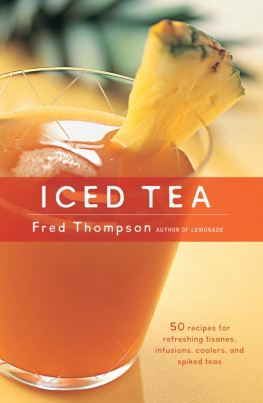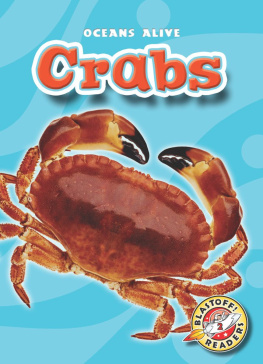The Harvard Common Press
535 Albany Street
Boston, Massachusetts 02118
www.harvardcommonpress.com
Copyright 2004 by Fred Thompson
Illustrations copyright 2004 by Chris Van Dusen
Recipe photographs copyright 2004 by Brian Hagiwara
All rights reserved. No part of this publication may be reproduced
or transmitted in any form or by any means, electronic or mechanical,
including photocopying, recording, or any information storage or
retrieval system, without permission in writing from the publisher.
Printed in China
Library of Congress Cataloging-in-Publication Data
Thompson, Fred.
Crazy for crab : everything you need to know to enjoy fabulous crab at
home / Fred Thompson.
p. cm.
ISBN 1-55832-265-5 (hc) -- ISBN 1-55832-266-3 (pb)
1. Cookery (Crabs) I. Title.
TX754.C83.T48 2004
641.6'95--dc22 2003018903
ISBN-13: 978-1-55832-266-0
ISBN-10: 1-55832-266-3
Special bulk-order discounts are available on this and other Harvard
Common Press books. Companies and organizations may purchase books
for premiums or resale, or may arrange a custom edition, by contacting
the Marketing Director at the address above.
10 9 8 7 6 5 4 3 2
Cover and interior design by Barbara Balch
Recipe photography by Brian Hagiwara
Illustrations by Chris Van Dusen
For additional photo credits, see
Dedication
For Lil'Bit, you make me proud
Acknowledgments
Before I can thank anyone for the help and inspiration I was given on this book, a huge heartfelt thank-you must go to all the men, women, and children who fish the waters of this great country and provide us not only with crabs, but with all the other tasty wonders of the water. It's hard and thankless work, and the people who do it, do it out of pure love of their community, their heritage, and nature. We all need to take a moment and remember these people who hold the keys to the wealth of the feast we put on our tables.
If ever an editor was inspired by a meal, it was Pam Hoenig and her delight over a freshly steamed crab. She was beside me and behind me every step of the way in creating this book. My agent, Lisa Ekus, helped make this book a reality. I'll be forever indebted to a dapper Southern lawyer from Hickory, North Carolina, Young Smith, who 5 years ago put in my hands William Warner's Pulitzer Prizewinning book Beautiful Swimmers, and set me on the right path.
So many people in the food world and coastal communities of this land have been kind and giving of their time: Beth Thomas, educational coordinator at the University of South Carolina's Baruch Marine Field Biology Laboratory at Hobcaw Barony, just north of Georgetown, South Carolina, who impressed upon me the absolute necessity of maintaining our saltwater estuaries if we wanted to keep eating seafood; the folks at the Chesapeake Bay Maritime Museum in St. Michaels, Maryland, who pointed me in so many great directions while I was on the Chesapeake Bay; the good people of Crisfield, Maryland, self-proclaimed Crab Capital of the World, who took me in as one of their own; the Crisfield Chamber of Commerce, for some award-winning Crab Derby Days recipes; Heidi Cusick, with the Mendocino (California) County Alliance, who gave so much of herself and her time and introduced me to Dungeness crab country. How can I forget Gene Mattiuzzo, who led me through the processing of Dungeness crab and regaled me with stories about crabbing on the north coast, keeping me laughing the whole time (and not many book interviews end with a toast of 40-year-old moonshine). Thanks to Linda Johnson, who ate all my leftovers and picked crabs when I got tired; Diane Collins, my physical therapist in New York, who became a gung ho crab recipe taster; B. A. and Sam Schlegel, who were a wealth of knowledge not only about the Florida crab business, but also about the Chesapeake Bay; and Pableaux Johnson, who always seemed to know when to call from his Louisiana home and give me a kick in the butt. A special thanks to Jordy Rosenhek, manager of Wild Edibles at Grand Central Terminal in New York City. His help and patience were beyond the call. And a big thank-you to all the chefs and home cooks whose recipes you'll find between these covers.
Without the great folks at The Harvard Common Press none of this could ever have been possible. They are such wonderful people to be partnered with in a project like this. And thank you to Brian Hagiwara for the wonderful photographs and to Barbara Balch, who shaped the vision of this book.
I'd be remiss not to mention Toni Allegro, a great person, a great teacher, and a great inspiration. Without her positive attitude, I doubt I would ever have written a thing.
Introduction
Crabmeat got me into trouble as a child. I was about 10 years old when I discovered the magical essence of crab. The problem came as I ate more than my share of crab claws at a cocktail party in Myrtle Beach, South Carolina. I was like a buzzard, swooping down on the bowl of claws and hightailing it like crazy. I couldn't help myself; those claws were just too good. I risked punishment and banishment with each raid, as my embarrassed father railed at me to stay away from the food. Finally, my parents' good friend Blanche Brown, the hostess, came to my rescue and sat me down in the kitchen with my own personal bowl of claws. So started a 30-plus-year love of the most cantankerous beast in the sea.
There's a saying about blue crabs that I suspect applies to the entire species: "Put one crab in a bushel basket, and it will find a way to climb out. Put two in a basket, and they'll fight each other so that neither will escape." Crabs love to fightwith each other and with us. The task of getting that luscious crab to the table can be difficult, but the end result is always well worth the effort.
Crabs have been very regional in nature until the past few years. Improved transportation has given seafood wholesalers the ability to make crabmeatand different crab typesavailable on a more widespread basis, challenging some regional preferences along the way. The blue crab's primary domain has long been considered the Chesapeake Bay. Folks along the eastern and western shores of the bay will quickly tell you that the Chesapeake blue crab and the methods they use to prepare the beast are superior to any other. The blue crab does exist elsewhere, though, in the sounds and bays along the Atlantic coast and in the Gulf of Mexico. People in these areas are just as proud of their crabs and the recipes that they have applied to them for decades. From the north coast of California to the cold waters of Alaska, another, larger crustacean holds court: the Dungeness crab. Sweeter, denser, and more meat with less trouble are the battle cries of the Dungeness troops. And what of King crabs and Jonahs, snow crabs, and the newly named peekytoe crab, which is really a rock or sand crab? Their fine taste also demands respect.
I should confess that I grew up on the East Coast, a few hours west of the blue crabrich estuaries of North Carolina. For more than half my life, the only "fitting" crabmeat came from a blue crab. The imported canned Dungeness crab that was available was poorly packed and contained more water than crab. Over time, I journeyed to the crab meccas of the East Coast: Faidley's in Baltimore's Lexington Market; the Crab Claw Restaurant in St. Michaels, Maryland; crab feasts in Crab City, aka Annapolis, Maryland; the National Hard Crab Derby & Fair in Crisfield, Maryland, the self-proclaimed Crab Capital of the World; Urbanna, Virginia, home to some of the best soft-shell crabs in the Chesapeake Bay; and the crabbers' enclave on King Street in Hampton, Virginia. I thought I knew crabs.
Then 2 years ago, I hunkered down on one of the stools at Swan Oyster Depot in San Francisco and was treated to not only divine Dungeness crab Louis but also to an education on West Coast crabs. Maybe all this crab business deserved another look.
Next page










![Henry Fox - Seafood Salads 365: Enjoy 365 Days With Amazing Seafood Salad Recipes In Your Own Seafood Salad Cookbook! [Tuna Recipes, Crab Cookbook, Healthy Seafood Cookbook, Mexican Seafood Cookbook] [Book 1]](/uploads/posts/book/288303/thumbs/henry-fox-seafood-salads-365-enjoy-365-days-with.jpg)




